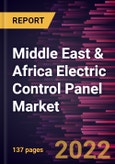The MEA electric control panel market is expected to grow from US$ 272.99 million in 2022 to US$ 393.81 million by 2030; it is estimated to grow at a CAGR of 4.7% from 2022 to 2030.
In several countries, electric control panels (ECPs) need to meet several regulatory requirements, including compliance with specified standards and listings. A manufacturer may incur overhead costs if the local authorities having jurisdiction (AHJ) identify unapproved panels in market. Earlier, most electric control panels in operation were powered with AC power sources, but DC power has become a norm today. Changes in control voltage specifications have resulted in more efficient power usage. When power entering the panel is used more efficiently, the components emit less heat, allowing them to be mounted in proximity in accordance with the safety ratings. Panel builders must adhere to air spacing requirements recommended by component manufacturers, which help in the efficient dispersion of heat - the closer components may be mounted, the smaller will be the panel's footprint. In addition to improvements in components that go into control panels, the manufacturing process of electric control panels has also been made better. Previously, a manufacturer would use a tape measure, straight edge, and marker to manually prepare the layout of each panel, followed by drilling and tapping the panel's holes. This inefficient, time-consuming, and dirty process has now been replaced with AutoCAD, wherein automated drilling systems are deployed to carry out drilling and cordless screwdrivers are used to put self-tapping screws, which have made panel manufacturing operations easier and faster. The AutoCAD process is not only more efficient and cleaner, but it also leads to the creation of a higher-quality product. Therefore, the need for higher quality control and panel fabrication creates an opportunity for the electric control panel market.
With the new features and technologies, vendors can attract new customers and expand their footprints in emerging markets. This factor is likely to drive the MEA electric control panel market. The MEA electric control panel market is expected to grow at a good CAGR during the forecast period.
In several countries, electric control panels (ECPs) need to meet several regulatory requirements, including compliance with specified standards and listings. A manufacturer may incur overhead costs if the local authorities having jurisdiction (AHJ) identify unapproved panels in market. Earlier, most electric control panels in operation were powered with AC power sources, but DC power has become a norm today. Changes in control voltage specifications have resulted in more efficient power usage. When power entering the panel is used more efficiently, the components emit less heat, allowing them to be mounted in proximity in accordance with the safety ratings. Panel builders must adhere to air spacing requirements recommended by component manufacturers, which help in the efficient dispersion of heat - the closer components may be mounted, the smaller will be the panel's footprint. In addition to improvements in components that go into control panels, the manufacturing process of electric control panels has also been made better. Previously, a manufacturer would use a tape measure, straight edge, and marker to manually prepare the layout of each panel, followed by drilling and tapping the panel's holes. This inefficient, time-consuming, and dirty process has now been replaced with AutoCAD, wherein automated drilling systems are deployed to carry out drilling and cordless screwdrivers are used to put self-tapping screws, which have made panel manufacturing operations easier and faster. The AutoCAD process is not only more efficient and cleaner, but it also leads to the creation of a higher-quality product. Therefore, the need for higher quality control and panel fabrication creates an opportunity for the electric control panel market.
With the new features and technologies, vendors can attract new customers and expand their footprints in emerging markets. This factor is likely to drive the MEA electric control panel market. The MEA electric control panel market is expected to grow at a good CAGR during the forecast period.
MEA Electric Control Panel Market Segmentation
The MEA electric control panel market is segmented based on form, type, industry, and country.- Based on form, the MEA electric control panel market is bifurcated into enclosed and open. The open segment dominated the market in 2022.
- Based on type, the MEA electric control panel market is bifurcated into low tension and medium and high tension. The medium and high-tension segment dominated the market in 2022.
- Based on industry, the MEA electric control panel market is segmented into manufacturing, chemical, automotive, food and beverages, power, oil and gas, pharmaceutical, aerospace and defense, and others. The power segment dominated the market in 2022.
- Based on country, the MEA electric control panel market is segmented into the UAE, Saudi Arabia, South Africa, and the Rest of MEA. The Rest of MEA would dominate the market in 2022.
Table of Contents
1. Introduction
3. Research Methodology
4. MEA Electric Control Panel Market Landscape
5. MEA Electric Control Panel Market - Key Market Dynamics
6. MEA Electric Control Panel Market - Country Analysis
7. MEA Electric Control Panel Market Analysis - By Form
8. MEA Electric Control Panel Market Analysis - By Type
9. MEA Electric Control Panel Market Analysis - By Industry
10. MEA Electric Control Panel Market - Country Analysis
11. Industry Landscape
12. Company Profiles
13. Appendix
Companies Mentioned
- ABB Ltd
- Cetal
- Eaton
- Leviton Manufacturing Co., Inc.
- Rittal Gmbh & Co. KG
- Rockwell Automation, Inc.
- Schneider Electric SE
- Siemens AG
- SIMON PROtec
Table Information
| Report Attribute | Details |
|---|---|
| No. of Pages | 137 |
| Published | September 2022 |
| Forecast Period | 2022 - 2030 |
| Estimated Market Value ( USD | $ 272.99 Million |
| Forecasted Market Value ( USD | $ 393.81 Million |
| Compound Annual Growth Rate | 4.7% |
| Regions Covered | Africa, Middle East |
| No. of Companies Mentioned | 9 |








